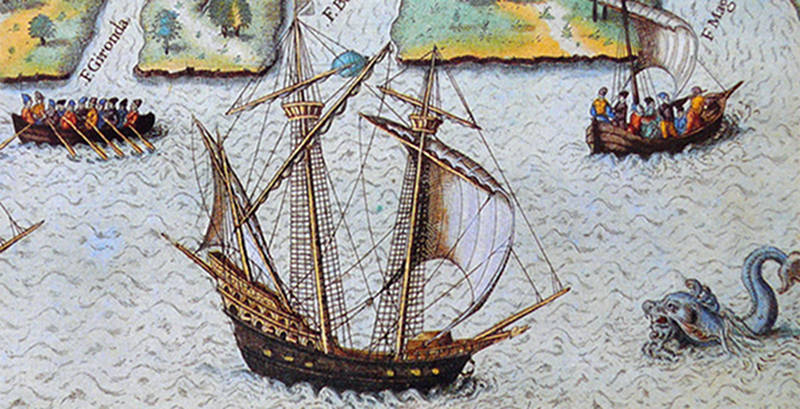
The essays below will help you to understand the goals and objectives of the mission and provide additional context and information about the places being explored and the science, tools, and technologies being used.

By Chuck Meide, Expedition Principal Investigator - Lighthouse Archaeological Maritime Program
July 14 - August 18, 2014
In the mid-16th century, France was eager to assert her claim to the New World, both to seize the opportunity for wealth and commerce and to ease religious tensions at home by providing a refuge for Protestant Huguenots. A series of fleets were sent to colonize the wilderness of “La Floride” starting in 1562, alternatively lead by Jean Ribault and René de Laudonnière.
The promising start at Fort Caroline on the River of May (the present-day St. Johns River in Jacksonville, Florida) would come to a bloody end shortly after Ribault’s 1565 arrival with a fleet of seven resupply ships, as the stage was set for a decisive colonial conflict between France and Spain. With the aid of a tremendous storm that would destroy Ribault’s four largest ships, Spanish forces lead by Pedro Menéndez would deal the death blow to France’s dream of Florida conquest.
Four and a half centuries later, archaeologists at the Lighthouse Archaeological Maritime Program (LAMP), the research arm of the St. Augustine Lighthouse & Museum, are dedicated to the search and discovery of the lost French Fleet of 1565.
Partnering with the State of Florida, the NOAA Office of Ocean Exploration and Research, the National Park Service, and the Institute of Maritime History and using research from the Center for Historical Archaeology, in July, the team surveyed a five-mile long stretch of the Atlantic Ocean off the Canaveral National Seashore using geophysical instruments including marine magnetometer, sidescan sonar, and sub-bottom profiler.
In August, after analyzing the magnetic and acoustic data, archaeologists returned to the search area to stage diving operations on potential shipwreck targets, in hopes of locating and identifying the remains of one or more vessels from the earliest French colonization attempt in North America.
By Chuck Meide
During the late summer of 2014, a team of maritime archaeologists conducted surveys of a five-mile long stretch of the Atlantic Ocean using geophysical instruments to identify potential shipwreck targets. Following the data analysis, the archaeologists returned to the survey area to conduct diving operations in order to physically inspect identified targets, in hopes of locating and identifying the remains of one or more vessels from the French fleet.
Read moreBy Chuck Meide
In early 1562, the Admiral of France, Gaspard de Coligny, convinced France’s Queen Mother Catherine de Medici to finance a colonization expedition to “La Floride.”
Read moreBy Chuck Meide
Upon his release from prison, Ribault was commissioned to lead the relief mission to Florida. Ribault’s fleet consisted of seven ships loaded with armament and munitions, supplies, livestock, 500 soldiers, and as many as 500 more seamen and colonists.
Read moreBy Chuck Meide
Ribault’s fleet consisted of seven ships, three of which were smaller than 100 tons and four of which were greater.
Read moreBy Chuck Meide
During the winter of 1970-1971 a group of Central Florida relic hunters discovered an archaeological site on the western or inland shore of the outer barrier island in what is now Canaveral National Seashore. The recovered artifacts indicated these sites were encampments inhabited by survivors from the French shipwrecks.
Read moreBy John de Bry
Over the last 20 years, I have carried out historical research in French archival repositories related to the French colonization of Florida. Among the most important documents I have discovered and translated are the commissioning and arming papers pertaining to the fleet in Dieppe (Normandy).
Read moreBy Dr. Sam Turner
The search for the lost French Fleet of Jean Ribault will be carried out using a suite of three remote sensing instruments. These include a marine magnetometer, an instrument carried by many of the space probes launched at Cape Kennedy just to the south of the project area, a side scan sonar, and a subbottom profiler.
Read more